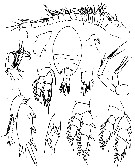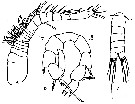|
|
 |
Fiche d'espèce de Copépode |
|
|
Calanoida ( Ordre ) |
|
|
|
Arietelloidea ( Superfamille ) |
|
|
|
Arietellidae ( Famille ) |
|
|
|
Paramisophria ( Genre ) |
|
|
| |
Paramisophria spooneri Krishnaswamy, 1959 (F,M) | |
| | | | | | | Ref.: | | | Krishnaswamy,1959 (p.543, figs.F,M); Othman & Greenwood, 1993 (p. 86) |  issued from : S. Krishnaswamy in J. mar. biol. Ass. U.K., 1959, 38. [p.544, Fig.1]. Female (from Plymouth, England): A, habitus (dorsal); B, posterior margin of metasome (lateral); C, labrum (lateral view); D, right caudal ramus (dorsal); E, A1; F, A2; G, Mx1; H-J, P1 to P3; K, P5; K1, end of the inner projection with the bifid end; L, lateral view of P5 showing the insertion of spines. Nota: Caudal rami wider than long and each ramus bears 6 setae, its inner margin is hirsute. A1 20-segmented, carries a number of aesthetes. A2 biramous, both the rami 2-segmented; endopod shorter than exopod (thus A2 differs from that of P. cluthae, where the endopod is 6-segmented and also carries a larger number of setae). Other oral appendages are as in P. cluthae, Mx1 however differs in that it shows a reduction in the number of setae it carries. P5 consists of a small basal segment and slender distal segment
|
 issued from : S. Krishnaswamy in J. mar. biol. Ass. U.K., 1959, 38. [p.545, Table 1]. Female: Setal formula of P2 to P4.
|
 issued from : S. Krishnaswamy in J. mar. biol. Ass. U.K., 1959, 38. [p.545, Fig.2]. Male: A, A1; B, P5 (r = right leg; l = left leg); C, urosome (dorsal). Nota: Urosome 5-segmented. Left A1 19-segmented and geniculate on the left side, having the last segment feebly and imperfectly hinged to the penultimate segment. A2, oral appendages and P1-P4 as in female. P5 5-segmented; on the left leg the 3rd and 4th segments carry an outer plumose spine each while the terminal segment which is spatulate is produced into 3 processes which are spinous, thus giving the appearance of a three-pronged process to the segment; on the right leg, the 2nd segment carries a blunt process which is long and reaches up to the end of the 4th segment; the 3rd and 4th segments carry 1 outer plumose spine each, the terminal segment is a long slender process with 2 teeth at its base on the outer side.
| | | | | Ref. compl.: | | | Holmes, 2001 (p.14, Rem.) | | | | NZ: | 1 | | |
|
Carte de distribution de Paramisophria spooneri par zones géographiques
|
| | | | Loc: | | | English Channel (Plymouth), W Ireland (Kilkieran Bay) | | | | N: | 2 | | | | Lg.: | | | (299) F: 0,62; M: 0,62; {F: 0,62; M: 0,62} | | | | Rem.: | This species resembles Paramisophria cluthae Scott very closely.
For Krisnnaswamy (1959, p.546) the presence of an inner lobe on the right P5 of the male necessitates an emendation of the generic diagnosis given by Sars (1903, p.127) to read as follows: ' those in male 5-segmented, with or witout any lobe inside the 2nd segment'. | | | Dernière mise à jour : 27/01/2015 | |
|
|
 Toute utilisation de ce site pour une publication sera mentionnée avec la référence suivante : Toute utilisation de ce site pour une publication sera mentionnée avec la référence suivante :
Razouls C., Desreumaux N., Kouwenberg J. et de Bovée F., 2005-2025. - Biodiversité des Copépodes planctoniques marins (morphologie, répartition géographique et données biologiques). Sorbonne Université, CNRS. Disponible sur http://copepodes.obs-banyuls.fr [Accédé le 04 décembre 2025] © copyright 2005-2025 Sorbonne Université, CNRS
|
|
 |
 |





